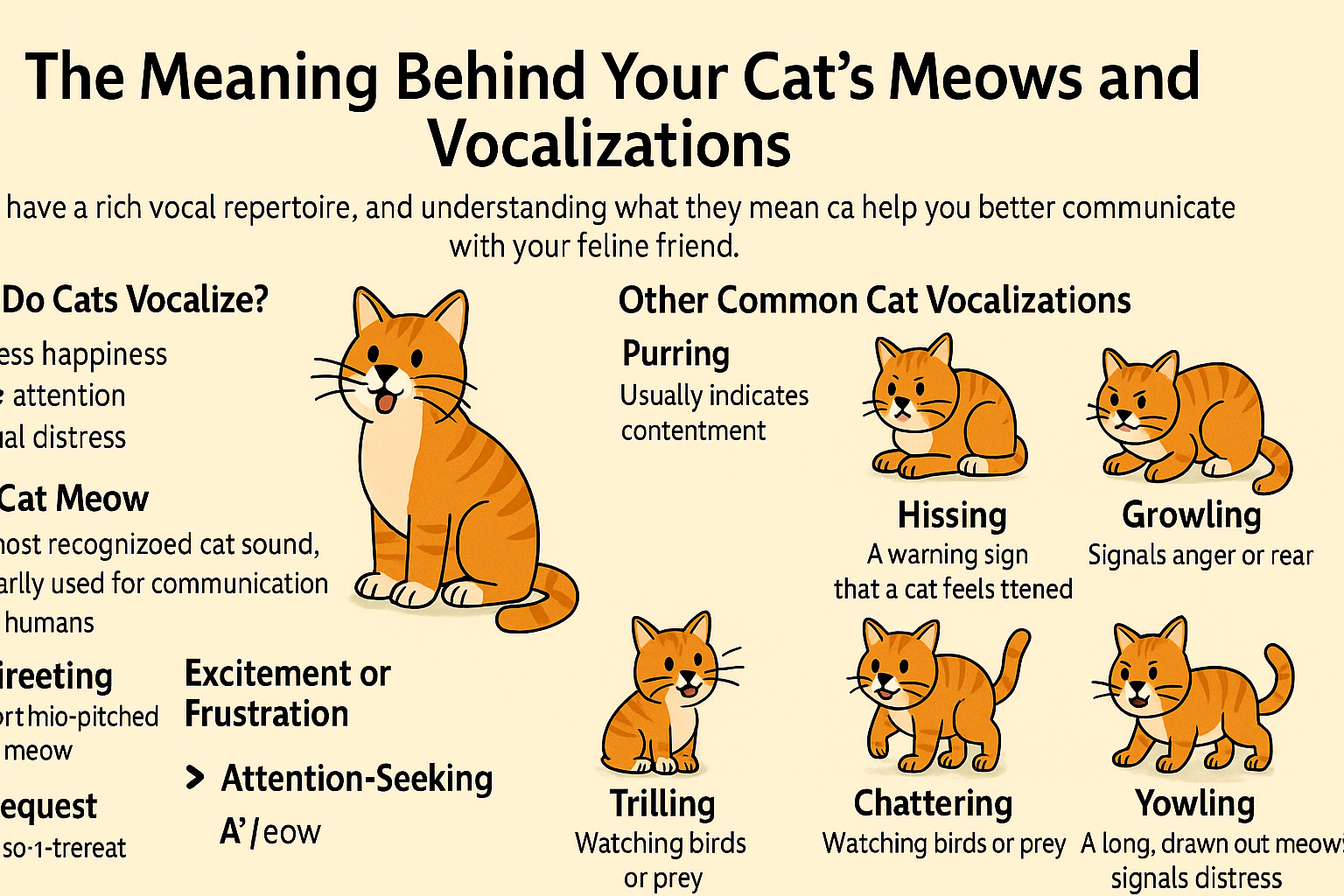Cats have lived alongside humans for thousands of years, yet their language remains a source of fascination and mystery. Every cat owner has experienced the wide range of sounds their feline companions make, from gentle purrs to demanding meows and even the occasional hiss or growl.
Understanding what these vocalizations mean is key to building a deeper bond with your cat and ensuring their well-being. In this article, we will explore the reasons behind your cat’s meows and other vocal sounds, how to interpret them, and what they reveal about your cat’s emotions and needs.
Why Do Cats Vocalize?
Cats communicate for several reasons, including expressing happiness, seeking attention, warning of danger, or signaling distress. Unlike dogs, whose vocalizations are more universally understood, cats have developed a complex system of sounds that are often tailored to their relationships with humans. Interestingly, domestication has significantly influenced the way cats communicate, especially through meowing, which is used far more often in interactions with people than with other cats.
The Evolution of Cat Communication
In the wild, adult cats rarely meow to each other. Most vocalizations between cats involve hissing, growling, or yowling, typically during confrontations or mating. Kittens, however, meow to their mothers to signal hunger or distress.
As cats grow up, this meowing usually stops-unless they are interacting with humans. Domesticated cats have learned that meowing is an effective way to get our attention, making it a unique feature of cat-human communication.

The Cat Meow
The classic “meow” is the most recognized cat sound and is almost exclusively reserved for communication with humans. Kittens meow constantly to attract their mother’s attention, but adult cats use the meow primarily to interact with people, not other cats.
What Does a Meow Mean?
A meow can have many meanings, depending on its pitch, duration, and context:
- Greeting: A short, high-pitched meow often serves as a friendly hello when you walk through the door.
- Request: A persistent or repetitive meow usually means your cat wants something, such as food, water, or access to another room.
- Excitement or Frustration: Rapid or loud meows may indicate excitement, while drawn-out, lower-pitched meows can signal frustration or even illness.
- Attention-Seeking: Sometimes, meows are simply your cat’s way of asking for playtime or affection.
- Distress: A sudden change in your cat’s meowing pattern, especially if it becomes excessive or sounds different, can be a sign of anxiety, boredom, pain, or illness. In such cases, a visit to the veterinarian is recommended.
Scientific Insights
Research has shown that humans are not always good at interpreting the exact meaning of different meows. In one study, participants were asked to identify the context of various meows-such as waiting for food, isolation, or brushing.
The most recognized was the “waiting for food” meow, but even then, only 40 percent of participants chose correctly. Cat owners performed better than non-owners, but the study highlights how nuanced cat communication can be.
Other Common Cat Vocalizations
While the meow is the most familiar sound, cats have a rich vocal repertoire. Scientific research has described up to 21 different feline vocalizations, and some experts believe there are even more. Here are some of the most common sounds and what they typically mean:
Purring
Purring is a rhythmic, vibrating sound that usually indicates contentment and relaxation. When your cat is curled up on your lap and purring, it’s a sign they feel safe and happy. However, cats also purr when they are in pain or frightened, possibly as a way to comfort themselves or seek help.
Hissing
A hiss is a clear warning signal. It means your cat feels threatened, scared, or uncomfortable. Hissing is often accompanied by other defensive body language, such as flattened ears and an arched back. If your cat hisses, it’s best to give them space.
Growling
Growling is another warning sound, signaling anger or fear. It’s your cat’s way of telling you or another animal to back off. If ignored, a growl can quickly escalate to more aggressive behavior, such as swatting or biting.
Trilling
A trill is a sweet, high-pitched sound that falls somewhere between a meow and a purr. Cats often use trills as a friendly greeting or to get your attention in a positive way. If your cat trills at you, they are likely happy to see you and may want some affection.
Chattering
Chattering is a rapid clicking sound made by a cat’s teeth, usually observed when they are watching birds or small animals through a window. This sound is thought to express excitement, frustration, or even mimic the killing bite used on prey.
Yowling
A yowl is a loud, drawn-out meow that typically signals distress, pain, or a desire to mate. Cats may yowl if they are stuck, looking for you, or feeling unwell. In unspayed females, yowling can also be a sign of being in heat.
Caterwauling
Caterwauling is a specific, intense vocalization made by female cats in heat. It’s a deep, wailing sound that serves to attract male cats. If your female cat hasn’t been spayed, expect to hear caterwauling during her heat cycles.
How Cats Use Vocalizations to Communicate with Humans
Cats have adapted their vocalizations to communicate specifically with humans. Unlike dogs, who often use body language and barking, cats rely more on vocal cues to express their needs and emotions. This adaptation is a result of domestication and the close relationship cats have developed with people.
Personalized Communication
Each cat develops a unique set of sounds and signals based on their interactions with their human family. Some cats are naturally more vocal than others, and certain breeds, such as Siamese cats, are known for their talkative nature.
Over time, cats learn which sounds are most effective in getting their owner’s attention, leading to a personalized “language” between cat and human.
Body Language and Context
While vocalizations are important, they are just one part of cat communication. Body language, facial expressions, and even tail movements play a crucial role in conveying a cat’s mood and intentions. For example, a cat may combine a soft meow with a slow blink to show affection, or pair a hiss with an arched back to signal fear.
Recognizing Changes in Vocalization
Paying attention to your cat’s vocal patterns is essential for their health and happiness. Sudden changes in the frequency, tone, or type of vocalizations can indicate underlying issues:
- Increased Meowing: May signal attention-seeking, hunger, or medical problems such as hyperthyroidism or dementia, especially in older cats.
- Excessive Yowling: Can be a sign of pain, anxiety, or being in heat.
- Silent Meows: Some cats open their mouths as if to meow but produce no sound. This can be a normal variation or, in rare cases, a sign of vocal cord issues.
If you notice any unusual changes in your cat’s vocal behavior, consult your veterinarian to rule out health problems.
Understanding the Emotional Context of Cat Vocalizations
Cats use their voices to express a wide range of emotions, from happiness and contentment to fear and frustration. Recognizing the emotional context behind their sounds helps you respond appropriately and strengthens your relationship.
Happy and Content Sounds
- Soft Meows and Trills: When your cat softly meows or trills, it usually means they are happy and comfortable. This often happens when they greet you, want to initiate play, or seek affection.
- Purring: As mentioned earlier, purring is a classic sign of contentment. Cats often purr while being petted or resting in a safe environment. However, purring can also occur when a cat is nervous or in pain, so context matters.
Anxiety and Fear
- Hissing and Growling: These sounds warn that your cat feels threatened or scared. It’s important to respect their space during these moments to avoid escalating stress.
- Yowling and Loud Meowing: Cats may vocalize loudly when they are anxious, lonely, or in pain. For example, a cat left alone for long periods might meow loudly to signal distress or seek attention.
Frustration and Excitement
- Chattering: When watching birds or squirrels, cats often chatter, a sound that combines excitement and frustration because they cannot reach their prey.
- Loud or Repetitive Meows: These can indicate frustration, especially if your cat is trying to get your attention for something they want or need.
How to Respond to Your Cat’s Vocalizations
Understanding your cat’s vocal signals is only half the equation. Knowing how to respond appropriately helps meet their needs and reduces stress for both of you.
Responding to Requests
If your cat is meowing persistently, try to identify what they want. Common reasons include hunger, thirst, wanting to play, or needing access to a different room. Responding consistently to their requests builds trust and communication.
Offering Comfort
When your cat is purring or softly meowing for attention, respond with gentle petting or playtime. This positive reinforcement encourages more comfortable and happy interactions.
Giving Space
If your cat hisses or growls, it’s best to give them space and avoid forcing interaction. Respecting their boundaries helps them feel safe and reduces aggressive behavior.
Monitoring Changes
If your cat suddenly starts meowing more than usual or changes the tone of their vocalizations, observe for other signs of illness or distress. A veterinary checkup is recommended if you suspect health issues.
The Role of Breed and Personality in Vocalization
Just like people, cats have individual personalities that influence how much they vocalize. Some breeds are known for being more talkative, while others are quieter.
- Siamese Cats: Known for their loud, frequent meows and a wide range of vocal sounds.
- Burmese Cats: Also quite vocal, often using trills and chirps to communicate.
- Maine Coons: Typically more laid-back but can be quite chatty when they want attention.
- Persian Cats: Generally quieter and less vocal.
Your cat’s personality also plays a big role. Some cats are naturally shy and reserved, while others are outgoing and expressive. Understanding your cat’s unique style of communication helps you interpret their vocalizations more accurately.
Training and Encouraging Healthy Communication
Cats can learn to communicate their needs more effectively with positive reinforcement. For example, if your cat meows at the door to go outside, you can reward them with attention or playtime when they use a specific sound or behavior. This helps establish clear communication channels.
Avoid Reinforcing Negative Vocalizations
It’s important not to reward excessive or demanding meowing, as this can encourage attention-seeking behavior that becomes frustrating. Instead, wait for a calm meow or other polite signals before responding.
Use Consistent Signals
Using consistent words or sounds when responding to your cat’s vocalizations helps them understand what you expect. For example, saying “dinner time” when feeding helps associate the word with the action, reducing anxious meowing.
When to Seek Help: Excessive Vocalization and Health Concerns
Excessive or unusual vocalizations can sometimes indicate medical or behavioral problems. Here are some situations when you should consult a veterinarian or animal behaviorist:
- Sudden Increase in Meowing: This could be a sign of pain, cognitive dysfunction (especially in older cats), or hyperthyroidism.
- Yowling at Night: Often linked to cognitive decline or anxiety.
- Vocalizations Accompanied by Other Symptoms: Such as changes in appetite, litter box habits, or activity levels.
- Persistent Hissing or Growling: May indicate stress, fear, or aggression that needs to be addressed.
Early intervention can improve your cat’s quality of life and prevent more serious issues.
Conclusion
Your cat’s meows and vocalizations are a window into their world. By paying close attention to the sounds they make and the context in which they occur, you can better understand their needs, emotions, and health.
Remember that every cat is unique, and their vocal communication will be shaped by their personality, breed, and experiences.
Building a strong bond with your cat means learning to listen, not just to their meows but to their entire language, including body language and behavior. With patience and observation, you can decode the meaning behind your cat’s vocalizations and create a happier, healthier life together.
- Parrotlets (Personality, Care, Health, Nutrition, & Cost) - June 20, 2025
- Caique (Personality, Care, Health, & Nutrition) - June 20, 2025
- The Complete Guide to Golden Retrievers - June 9, 2025














